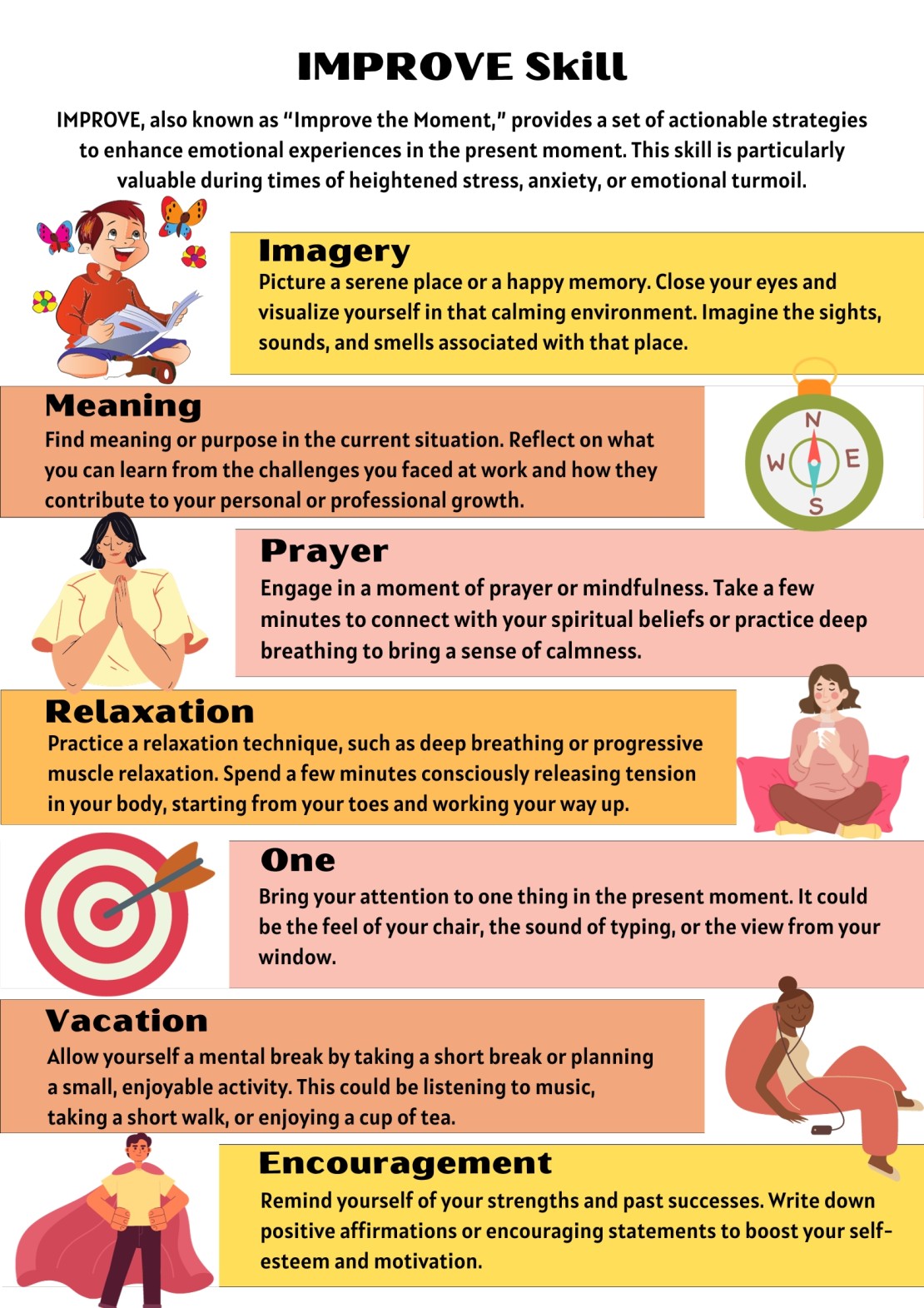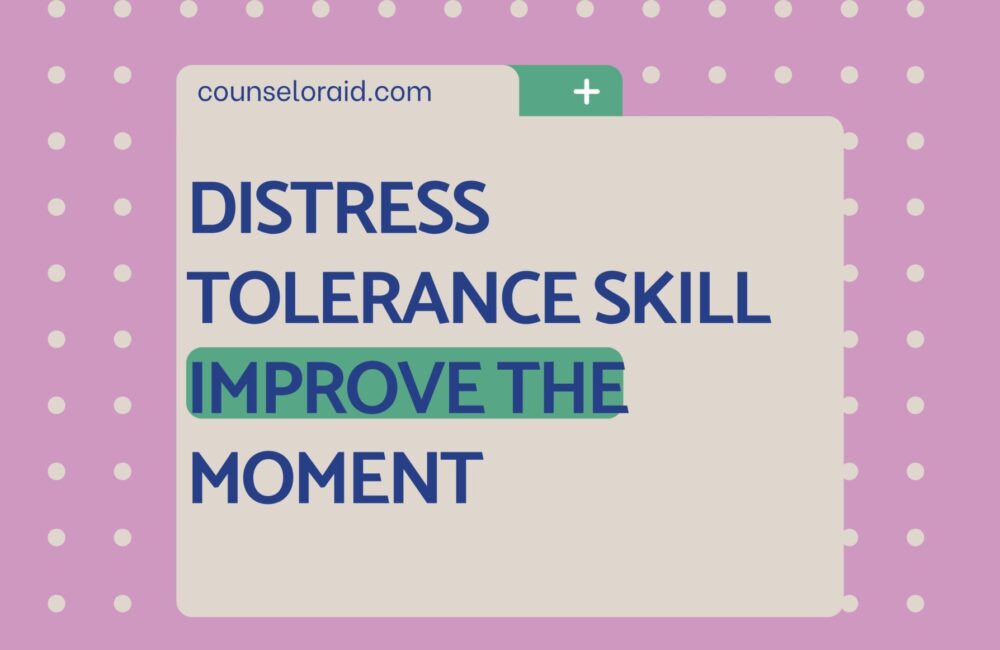Dialectal Behavioral Therapy, or DBT, has emerged as a widely accepted therapy to treat several mental disorders. Conceived by Dr. Marsha M. Linehan in the late eighties, it has proved a valuable therapeutic approach in treating emotional and behavioral changes, particularly borderline personality disorder (BPD). The core of DBT lies in its various skills designed for dynamic crisis management and transforming mindsets into a more positive thought process. Standing out among the different DBT skills is “Improve,” which fosters personal growth and emotional resilience.
Understanding DBT IMPROVE
DBT Improve is designed to help individuals navigate and transform their emotional experiences effectively. IMPROVE was conceived to replace a current emotional crisis or unpleasant moment with positive actions to change the negativity of the moment into a more pleasant and tolerable one. Essentially, IMPROVE is rooted in the principles of dialectics, which seek to integrate opposing forces to create a harmonious whole. It draws on cognitive-behavioral strategies and mindfulness practices to empower individuals to take charge of their emotional well-being.
What is IMPROVE?
IMPROVE is one of the core elements of Distress Tolerance, one of the four models of Dialectical Behavioral Therapy. Distress tolerance skills in DBT are strategies that help you overcome difficult emotions and situations, making them more tolerable and acceptable. There is no point in trying to change a problem, but what can be changed is how you feel about it. This is what DT teaches, providing you with coping mechanisms to reduce your vulnerability to negativity. It helps you respond better to your distress to avoid impulsive behavior or harmful actions.
Improve, also known as “Improve the Moment,” provides a set of actionable strategies to enhance emotional experiences in the present moment. This skill is particularly valuable during times of heightened stress, anxiety, or emotional turmoil. It is based on components that together form the acronym IMPROVE, with each letter representing a practice that can help you manage overwhelming situations.
Key Components of the Improve the Moment Skill

IMAGERY
Visualization is a potent tool for altering emotional states. Individuals can create a mental oasis of serenity by conjuring positive and calming mental images. Imagery helps improve the moment by using calming or inspiring mental ideas to distract from distress. This can involve a relaxing day at the beach or a hike in the woods or mountains.
The best way to practice imagery is to relax your mind and envision yourself in your happy place. Trying to conjure up details of a desired destination helps a great deal in enhancing the experience. Besides outdoor destinations, your comfortable place could be that perfect room fixed exactly how you want it. You could imagine a cozy fireplace, calming wall colors, aesthetic décor of your choice, and maybe a window that looks out onto beautiful scenery. You could also imagine yourself with a partner or friend.
MEANING
Improve the moment by creating meaning in the current situation to make it more tolerable. This also helps you find meaning in challenging conditions and allows individuals to reframe their experiences and derive a sense of purpose from adversity. For a therapist, the meaning skill can include questions based on an individual’s philosophical, existential, or theological beliefs.
Moreover, in trying to find purpose, one can also question current emotions about an ongoing emotional situation, asking if it could be transformed into a more positive one. Questions such as:
- “Should I allow this situation to dictate my life?”
- “How can I turn this experience into something that benefits me?”
- Can this situation immobilize or motivate me?”
- “Is this part of God’s greater plan for me?”
Such questions force our minds to introspect and create a better understanding of a situation to manage it. The result of meaning is to gain inspiration from one’s situation, turning it around for motivation and emotional benefit. To put it bluntly, it’s making lemonade out of lemons.
PRAYER
For those with spiritual inclinations or connections, prayer can be used to pray for courage. Incorporating prayer or repeating affirmations (mantras) can be a source of strength and comfort. This practice can also extend beyond religious boundaries, offering a way to connect with a higher power or inner resilience. Besides a supreme being or God, prayer can be addressed to your higher self or wise subconscious mind.
According to Marsha Linehan, prayer can also be that of acceptance, where you open yourself up to your deity. Acceptance prayer is an intelligent way of acknowledging and being mindful of your distress. You aren’t fighting it, but at the same time, you aren’t okay with it either, and praying is seeking the compassion of your deity to give you strength to accept and manage your ordeals.
RELAXATION
Relaxation in DBT refers to relaxing and calming the entire body to activate the parasympathetic nervous system. DBT Improve introduces various relaxation techniques, including progressive muscle relaxation and deep breathing exercises, as techniques to reduce stress and induce a holistic sense of calm. Some examples are enjoying a coffee over a book, a massage, or a nice hot bath; it could even be meditation.
Since there is a definite, proven connection between the body and mind, the main goal of relaxation is to not fight reality in both body and spirit. When you try to calm your body, you also relax your mind.
ONE THING IN THE MOMENT
One Thing in the Moment is the same as mindfulness. Being mindful and focusing on one thing at a time, taking it step by step, prevents you from being overwhelmed. Mindfulness, or living in the moment, cultivates self-awareness and helps you acknowledge and improve emotional situations with proactive and positive thoughts and actions.
Quite often, the memories of our past traumatic experiences crop up, making us fearful that we might experience the same in the future. This can bring about a wave of intense emotions, but the trauma can be reduced by being mindful of the present, focusing on it instead of the past. The best way to achieve this is through mindfulness exercises, which can also include meditative techniques.
VACATION
Improve your moments by taking a mental vacation. This helps you temporarily escape mentally from the situation. Mental breaks can cultivate a sense of enjoyment and pleasure to distract from the ongoing negative emotions.
The idea behind a vacation is to remove yourself from your current atmosphere and circumstances. There are other ways to take a mental break. For example, you could even perform a mental vacation exercise in your office when things get too stressful. You could shut your door, lie on a couch, close your eyes, and visualize yourself off to your desired destination. There are rules to the exercise, and you should avoid thinking about places that could be harmful or risky. Moreover, don’t prolong the mental vacation; just perform the exercise until you are calm again. Brief breaks help you move on from whatever it is that is disturbing you.
ENCOURAGEMENT
Improve your moment with positive affirmations and encouragement. Talk aloud to yourself, using encouraging words. Self-reaffirmations can help build confidence, overcome fear and self-doubt, and reduce self-sabotage. It enables you to believe in yourself. Encouragement also includes identifying comforting activities, whether a warm bath, a favorite meal, or a cherished hobby, and providing a tangible means of self-compassion and self-care.
Dialectical Behavior Therapy is a multifaceted approach to emotional well-being, and every element of it, including the IMPROVE skill, covers coping mechanisms to navigate life’s complexities. The 7-point model of DBT Improve equips individuals with a versatile toolkit for emotional mastery that can be incorporated into daily life. The model can help individuals embrace a more intentional and balanced approach to their emotions. DBT is more of a philosophy that empowers people to participate in their emotional well-being actively and, in doing so, lays the foundation for a more fulfilling and authentic life















